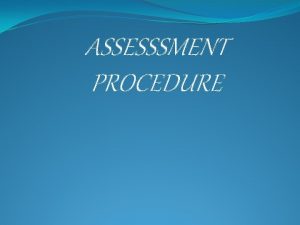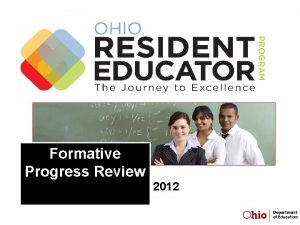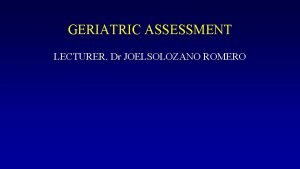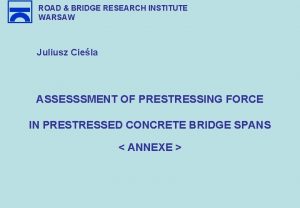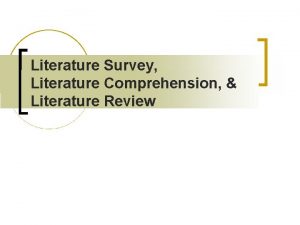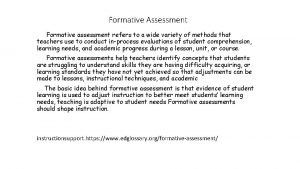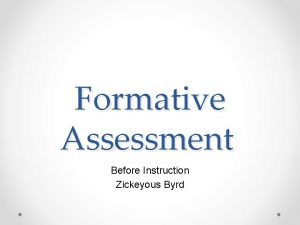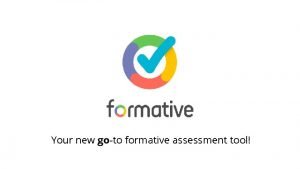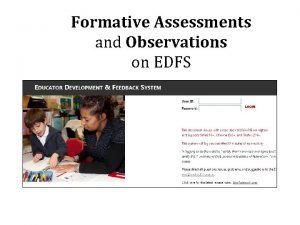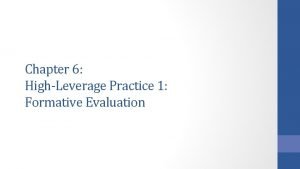Digital formative assesssment A review of the literature



















- Slides: 19

Digital formative assesssment: A review of the literature Janet Looney 10 June 2021

The literature review on the “state of the art” in digital formative assessment (DFA) was developed as an early output of the Assess@Learning policy experimentation (2019 – 2022; led by European School. Net, Brussels) Background aims of the literature review The review aimed to: Develop a working definition of “digital formative assessment” (DFA) Identify different technologies and their potential to support assessment for student learning (their learning environments, capacity to support individual student needs as well as their capacity to support student collaboration). Develop a typology to guide identification of good practices in. DFA in participating Member States

Working definition of DFA Digital formative assessment includes all features of the digital learning environment that support assessment of student progress and which provide information to be used as feedback to modify the teaching and learning activities in which students are engaged. Assessment becomes ‘formative’ when evidence of learning is actually used by teachers and learners to adapt next steps in the learning process. Source: Assess@Learning Partners, 2019; Black and Wiliam, 2010

Black and Wiliam propose a model for the design of educational activities influenced by theories of pedagogy, instruction and learning and by subject disciplines (and theories of learning need also to redress the neglect of assessment). Subject learning, requires the development of ‘disciplinary habits of mind’ (see also Yorke, 2003). Model for assessment in relation to pedagogy

The Black and Wiliam model is centred on planning and design structured around: Conceptual issues and debates • learning and content aims, which are then used to guide the sequencing of specific activities, with successive activities stimulating learning from previous work. • tasks designed to engage learners so as to elicit evidence of their understanding. The teacher may then infer appropriate next steps in instruction. • dialogue not only to assess student understanding, but also to develop the ‘. . . sociocultural aspects of learning, the habits of collaboration and of working in and through a community’ (p. 556). • links to earlier learning and open to broader perspectives. Students are given the opportunity develop their thinking with longer answers (other than single-word responses).

The digital learning environment –within the typology, ‘learning environment’ refers to the use of digital platforms and tools to structure learning and content aims, to guide and sequence activities, and to elicit evidence of understanding). It may involve a combination of technologies as well as face-to-face interactions. Assess@Learning Typology Student-centred learning and assessment –emphasises the importance of student agency, including student-centred learning and assessment to identify and adapt learning. Student collaborative learning and assessment - emphasises the importance of student collaboration and collective engagement in learning and assessment.

As teachers plan to integrate these different tools and platforms, they need to take their different affordances and limitations into account. For example: Web 2. 0 platforms provide opportunities for students to engage in self-directed learning and to interact with each other Integrating technologies in lesson designs Other online platforms, such as digital games, may provide automated feedback and scaffolding and help teachers to identify student performance / reinforce recent learning. Inquiry-based learning projects, multi-player online games and other platforms focus students in collective problem solving – with assessment focused on progress toward solving the problem rather than on each student’s specific approach. And so on….

Draft typology

Draft typology, cont.

Draft typology, cont.

Some highlights from the literature review Learning analytics may be used to predict learner performance, to recognise patterns that relevant to leaners’ needs, and to support more personalised learning environments (Siemens, 2012; Verbert et al. , 2012). Data on student learning (e. g. gathered through clicker data, online behaviours) may support visualisations of learner progress (e. g. in a dashboard format) Students may also use digital tools – such as e-coaches, to track their own learning progress and consider suggested next steps

Some highlights from the literature review Educational Data Mining (EDM) is closely related to learning analytics, but is more concerned with research on learning processes and patterns in very large collections of educational data (Romero and Ventura, 2013) and may be used to improve digital learning platforms (e. g. automated feedback or scaffolding of next steps). A CAUTION: “AI systems predict our acts using historical data averaged over a large number of other persons. AI systems cannot understand people who make true choices or who break out from historical patterns of behaviour. AI can therefore also limit the domain where humans can express their agency. ” (Tuomi, 2019)

Some highlights from the literature review Classroom polling technologies use student response systems (e. g. clickers or students’ cell phones) for rapid assessment of student understanding and to guide next steps in classroom discussions (Thomas and Mc. Gee, 2012). Teachers who have ‘thinking-focused’ goals are more likely to use the new technologies to deepen their assessment practices, to focus student reflection on critical elements of learning science and to foster student skills for self-assessment (e. g. Yarnall et al. , 2006). Student response systems may strengthened FA by providing student anonymity and allowing teachers to organise discussions to respond to whole class needs. (Beatty and Gerace, 2009).

Mobile learning, by definition, opens possibilities for learning ‘anytime, anywhere’. This may involve opportunities for situated learning, or to have ready access to study tools and opportunities to engage with peers and/or to received automated feedback. Some highlights from the review Mobile learning includes some features of Web 2. 0 (smartphone and tablet access to Internet) as well as texting features, and tools to take pictures, make audio recordings to support multi-media assessment. Mobile learning,

Digital games increase motivation, support collaboration, help to develop digital literacy skills, increase attention and retention of learning, provide opportunities for self-regulated learning (Annetta et al, 2009 Some highlights from the literature review Digital games provide immersive learning experiences in a situated context. Real-time and integrated formative feedback Scaffolded learning, with increasing levels of complexity introduced as learners advance through the game (Milrad, Spector and Davidsen, 2003) Bhagat and Spector highlight emerging technologies, including ‘stealth’ assessments (e. g. the learner is unaware that he/she is being assessed) automated concept map-based assessments that gather evidence as to how learners are thinking about a problem, visualisations that support learner self- assessment and self- regulation, and tools to support learner collaboration and social networking.

Shih, Chu, Hwang and Kinshuk (2011) describe a programme to support learning of botany developed by a team of teachers Some highlights from the literature review one teacher who had created a campus plant encyclopedia; another with expertise in information technology; and a third who had designed a ‘repertory grid method’ to classify the characteristics of the campus plants and context-aware technology Students were able to access to compare pre-designed learning materials on their mobile devices with features of real plants. The programme tracked individual learning behaviours and offered personalised support. Students appreciated the opportunity to learn at their own pace. They also interacted frequently with classmates to complete learning goals. The authors also note that in their analysis of results, they found no significant differences in performance between high- and lowachieving students (Shih, Chu, Hwang and Kinshuk, 2011)

Jiminez and Moorhead (2017) describe a project to support 10 th year history students to create their own multi-modal textbooks using open education resources alongside textbook authoring software /Web 2. 0 technology. Some highlights from the literature review A main aim of the project was to help students develop their capacity to understand reconcile differing viewpoints on history, and critically assess the potential value of digital sources. The course designers collaborated with local archivists on use of digitised artefacts, on copyright and use of primary sources. Students developed interactive images, galleries with collections of relevant images, scrolling sidebars with historical documents and textual analysis, and so on to draw readers’ attention to different perspectives and to develop meaningful narratives. Student critiqued existing digital texts and also reviewed each other’s work and made suggestions for improvement – referring to principles of good design.

Rahimi, van den Berg and Veen (2015) argue that teachers need a more robust ‘learning model’, and propose a 4 -stage process model for design instructional approaches that engage students in complex problems 1. Forethought (providing choices) Some highlights from the literature review 2. Performing (scaffolding) –activities are aimed at appropriate level. Learners produce and co-author content, communicate and collaborate with peers, connect with relevant people, add learning resources to their personal learning environment. 3. Reflecting (assessing) –Students evaluate their learning strategy and outcomes and consider how to improve. Teachers involve students in a dialogue. Process-based assessments are needed to track cognitive, social and personal development. These may be augmented by learning analytics. 4. Feeding back (applying) – students should be encouraged to actively participate in constructing and re-shaping the learning environment. This feedback to teachers can support learning and improvement in teaching with new technologies.

Evidence-centred design can support better alignment of formative and summative assessment. Integrating formative and summative assessment Assessment designers decide first on the complex skills, knowledge or other attributes that are to be measured, and then the tasks or situations that will provide evidence of student proficiency. The link between the evidence to be derived from the assessment and the claims about student proficiency are made explicit (Mislevy and Haertel, 2006 in Ganes et al. ). The nature of the construct guides selection or development of relevant tasks and the construct-based scoring criteria and rubrics (Messick, 1994). More R&D needed to develop digital assessment technologies to support reliable measurement of higher-order thinking, complex task performance (e. g. for large-scale assessments) (O’Leary, et al. , 2018).
 Assesssment
Assesssment Hát kết hợp bộ gõ cơ thể
Hát kết hợp bộ gõ cơ thể Slidetodoc
Slidetodoc Bổ thể
Bổ thể Tỉ lệ cơ thể trẻ em
Tỉ lệ cơ thể trẻ em Gấu đi như thế nào
Gấu đi như thế nào Chụp phim tư thế worms-breton
Chụp phim tư thế worms-breton Chúa sống lại
Chúa sống lại Các môn thể thao bắt đầu bằng tiếng bóng
Các môn thể thao bắt đầu bằng tiếng bóng Thế nào là hệ số cao nhất
Thế nào là hệ số cao nhất Các châu lục và đại dương trên thế giới
Các châu lục và đại dương trên thế giới Công của trọng lực
Công của trọng lực Trời xanh đây là của chúng ta thể thơ
Trời xanh đây là của chúng ta thể thơ Cách giải mật thư tọa độ
Cách giải mật thư tọa độ Phép trừ bù
Phép trừ bù độ dài liên kết
độ dài liên kết Các châu lục và đại dương trên thế giới
Các châu lục và đại dương trên thế giới Thơ thất ngôn tứ tuyệt đường luật
Thơ thất ngôn tứ tuyệt đường luật Quá trình desamine hóa có thể tạo ra
Quá trình desamine hóa có thể tạo ra Một số thể thơ truyền thống
Một số thể thơ truyền thống
